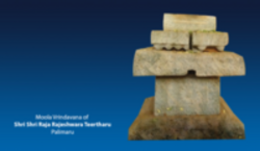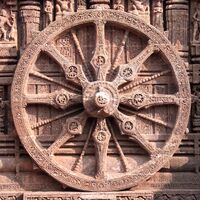Sri Raja Rajeshwara teertha virachitam Mangalaashtakam
Translated by Sri Hunsur Sriprasad.
Introduction
‘ashTa’ means eight in Sanskrit. ‘ashTaka’ means octet or a set of eight items. Normally it is used to describe any poetic composition that has 8 verses, with a ninth verse to list the benefits of reciting the ashTaka. Mangala means auspicious or propitious. So a mangalaashtaka is a set of 8 (or 9) verses whose recitation or utterance brings us auspiciousness.
There are plenty of ashTakas in devotional literature. Krishnaashtaka, Hariyashtaka, etc are some well known ashtakas. However there is nothing comparable to the one composed by Sri Raja Rajeshwara yati. In just 8 verses this mangalaashtaka provides a panoramic view of the entire universe, drawing our attention towards all divine and auspicious entities and beings that are worth of being extolled. No other ashtaka provides such a sweeping coverage of all auspicious beings. Singing this mangalaashtaka during weddings is very common and done by people of different castes and creeds. This is a testimony to the popularity of this work and its universal appeal.
About the Author – Sri Raja Rajeshwara yati (1400 – 1440 AD)
Phalimar matha (monastery) is one of the 8 mathas established by Acharya Madhva. Sri Hrisheekesha teertha, the first disciple of Acharya Madhva, was the first pontiff of this matha. He was followed by Sri SammaatmEsha teertha, Sri Sambhava teertha Sri Aparaajita teertha and Sri Vidyaamoorthi teertha. Sri Vidyaamoorthi teertha gave sanyasa to a young boy and named him Sri Raja rAjeshwara yati. He was a great scholar whose brilliance mirrored those of his guru (Sri Vidyaamoorthi teertha) and his parama guru (Sri Aparaajita teertha).
Sri Raja rAjeshwara yati was also blessed with poetic talent. In addition to this Mangalaashtaka, he has also composed another work called “Sri Raama sandesha”. In this, he has beautifully captured the essence of Raamayana, just as he has captured all the salient points of the universe in the Mangalaashtaka. Scholars consider this work to be a monument to his mastery over poetry. These two works give us an idea of his greatness as a scholar. He travelled throughout the country in his youth and accumulated a lot of experience. In addition to his poetic brilliance he was also a very great scholar. Nyaaya shaastra, considered to be a challenge for any scholar, was like child’s play for him. He was feted everywhere for his scholarship and his saintliness. The king of Kantaavara was so impressed by his scholarship that he gifted him an entire village. He had this gift inscribed on an inscription and declared that all the revenue accruing from that village was to be used by the authorities of Phalimaar Matha. Sri Raja rAjeshwara yati passed away at a fairly young age without taking over the reins of the Matha. That is why his name ends with ‘yati’ and not ‘teertha’ (‘teertha is the honorific given to a person who becomes the peeThaadhipati or Head of the Matha). The brindaavana of this great soul is present in the main complex of Phalimar matha. Incidentally, this is the oldest brindaavana in the Phalimar lineage as brindaavanas of ascetics preceding him are not known.
Chandas (Poetic metre):
The entire work is in ‘shArdUla vikrIdita’ Chandas. This is the same metre used in the first half of the first verse of Nakha stuti (‘paantvasmaan puruhUta …pratyEka vajraayita). The second verse of nakha stuti (‘lakshmIkaanta samantatopi …brahmEsha shakrOtokara)’ is completely in this metre.
In this metre, each line consists of 19 characters, arranged as follows – ma, sa, ja, sa, ta, ta and a guru (GGG LLG LGL LLG GGL GGL G). There is a ‘yati’ or logical break after the 12th and the 19th characters..
Structure of the mangalaashtaka :
In the first verse he extols Lord Hari (Vishnu), the Almighty and supreme entity. He mentions Lakshmi and all the major male gods or celestial beings who are worshiped on Earth but does this in an interesting way.. He shows how they are connected to the Lord and how they serve Him. He starts with the auspicious word “Lakshmi”.
In the second verse he expands the list of gods mentioned in the first verse and identifies the main celestials we need to venerate. Here he includes their wives also but does not mention them by name.
In the third verse he identifies all the major sages and ascetics mentioned in shastra. He says they have sought refuge in the Lord’s lotus feet and are thus venerable to us.
In the fourth verse he lists all the main emperors and kings who ruled over Earth. In this list he includes Raama also, even though He is an incarnation of Lord Vishnu.
In the fifth verse he lists all the major mountains and hills that are venerated in shastra. Some of these are physical structures that are documented in maps and some are mystical, visible only to gyanis and celestials.
In the sixth verse he lists all holy Indian rivers that are known to shastra and worshipped for their ability to cleanse humans of their sins. His focus is not on the physical river that is visible to everybody but on the divine entity who regulates the river and maintains its sanctity.
The universe consists of two layers – roopaatmaka and naamaatmaka prapanchas. The first one is the collection of all objects having name and form that constitute the physical world; the second is the literary world. Having listed all entities in the roopaatmaka prapanch in the first six verses, he moves on the naamatmaka prapancha in the seventh verse. Here he lists all major literary forms like Vedas, Upanishad, Puraanas, Vedanta etc.
In the eight verse he lists all the major constructs and concepts in the area of astrology and astronomy. He also covers major divisions of time like samvatsara (year), maasa (month) etc.
In the ninth and final verse he documents the benefits that accrue to anyone who recites this mangalaashtaka . He says it can confer all desires and destroy all inauspiciousness. The person who recites this during a wedding and other auspicious events, or during Sandhyaakaala (dawn and dusk), obtains Dharma (righteousness), Artha (wealth) and all other desires.


